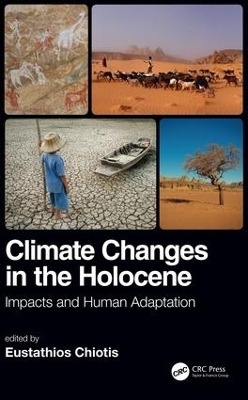
Climate Changes in the Holocene:
Crc Press Inc (Verlag)
978-0-8153-6593-8 (ISBN)
Significant climate changes have been recorded in natural archives during the Holocene, including the rapid waning of ice sheets, millennial shifting of the monsoonal fringe in the northern hemisphere, and abrupt centennial events. A typical case of severe environmental change is the greening of Sahara in the Early Holocene and the gradual desertification again since the fifth millennium before present.
Climate Changes in the Holocene: Impact, Adaptation, and Resilience investigates the impact of natural climate changes on humans and civilization through case studies from various places, periods, and climates. Earth and human society are approached as a complex system, thereby emphasizing the necessity to improve adaptive capacity in view of the anthropogenic global warming and ecosystem degradation.
Features:
Written by distinguished experts, the book presents the fundamentals of the climate system, the unparalleled progress achieved in the last decade in the fields of intensified research for improved understanding of the carbon cycle, climate components, and their interaction.
Presents the application of paleoclimatology and modeling in climate reconstruction.
Examines the new era of satellite-based climate monitoring and the prospects of reduced carbon dioxide emissions.
Eustathios Chiotis graduated from the National Technical University of Athens (NTUA) in Mining Engineering (1966), received a first MSc degree in Mineral Exploration at the Imperial College (IC), London, a second one in Petroleum Engineering also from IC, and his PhD from NTUA (1990). He served as director of geophysics at the Public Petroleum Corporation of Greece, Athens, and director of mineral resources evaluation at the Institute of Geology and Mineral Exploration of Greece, Athens. He has published papers on plate tectonics and the lithospheric structure in the Aegean Sea, oil exploration, Archaeometry and ancient aqueducts in particular. He co-edited the CRC Press handbook on "Underground Aqueducts" (2017) and investigated the climate deterioration as a motive for the innovative exploitation of groundwater. His areas of interest include mineral exploration and mining, petroleum engineering and geophysics, geothermal energy and drilling, Archaeometry and Ancient Greek Technology, Palaeolithics and Quaternary Geology.
Earth’s Climate – Past and Present. Introduction. Brief description of 4.6 billion-year climate history. Climate of the Holocene. Reconstruction of Past Climates. Climate Network. External Climate Forcings. Internal Climate Forcings. Climate Sensitivity. Human Responses to Climate throughout the Holocene. Homo Sapiens-Migration out of Africa. Cultural Stages and Migrations in the Holocene. Linguistic Phylogenetics of Indo-European Dispersal. Population Genomics in Eurasia. Near East- Eastern Mediterranean and the Egypt of Nile. The Green Sahara and Maghreb Aridification. Iran, the Indus Valley and India. Central and Northern Asia. Eastern Asia-China. Pacific-Australia. Peruvian Andes. Mesoamerica and the Classic Maya. Looking Ahead – Evaluations and Strategies Regarding Future Climate Changes. Hydrology and Water Supply under Modern-Day Climate. Extreme Weather Events and Changing Climate – Is there a correlation? Perspectives of Environmental Engineering for Sustainable Development. Principles and Criteria for Environmental Policy Making. Index.
| Erscheinungsdatum | 23.11.2018 |
|---|---|
| Zusatzinfo | 7 Tables, black and white; 22 Illustrations, color; 104 Illustrations, black and white |
| Verlagsort | Bosa Roca |
| Sprache | englisch |
| Maße | 178 x 254 mm |
| Gewicht | 1043 g |
| Themenwelt | Naturwissenschaften ► Biologie ► Ökologie / Naturschutz |
| Naturwissenschaften ► Geowissenschaften ► Geologie | |
| Naturwissenschaften ► Geowissenschaften ► Meteorologie / Klimatologie | |
| ISBN-10 | 0-8153-6593-4 / 0815365934 |
| ISBN-13 | 978-0-8153-6593-8 / 9780815365938 |
| Zustand | Neuware |
| Haben Sie eine Frage zum Produkt? |
aus dem Bereich


